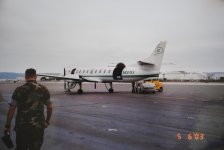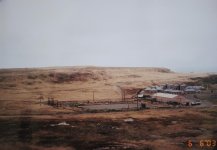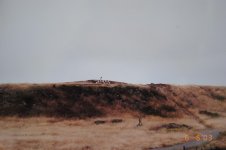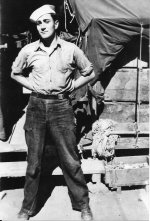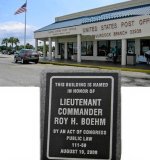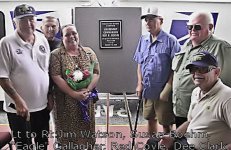OLDNAVYMCPO
US Veteran, Absent Comrade
The Second World War ushered in new methods of warfare. Just as Vietnam introduced Air Assault and the use of the helicopter, WWII promoted the need for amphibious warfare.
Although the Marines had been working diligently to develop the means and methodology for amphibious assault since the 1930's, the US was behind the curve in this new technology as the war began. As in any learning experience of this magnitude, mistakes were made. The corrections of which led to new equipment and new methods. Close air support and the Higgins Boat are just two such examples.
In the island hoping campaign in the Pacific, one of the most glaring debacles occurred at the Tarawa Atoll in the Gilbert Islands. In all previous amphibious assaults, US forces were unopposed on the beaches, opposition came inland. On Tarawa, the 4,500 man Japanese force was well prepared with heavy fortifications and artillery.
What made Tarawa so unique was the unpredictability of the tides and the failure of the Naval Task Force Commander to heed the advice of his New Zealand Liaison Officer who knew the tides would be unsuitable on the day of the landings. The Higgens Boats needed 5 feet of water over the reef to reach the beach. The tide was a paltry 3 feet, only the LVT "alligators" could get across. But even if the LVTs made it to the beach, they couldn't breach the seawall. Under intense fire, many of the un-armored LTVs were holed by enemy fire and couldn't float. They were stuck 500 yards off shore. By the end of day one, half the LTVs were out of service.
The 76 hour battle resulted in 3,166 US casualties. Of 3,636 Jap defenders only one officer and 16 enlisted surrendered. Of the 1,200 Korean slave laborers only 129 survived.
The unprecedented US losses on Tarawa led to congressional investigation and public outcry. The failures at Tarawa also demonstrated to the Navy the need for hydrographic reconnaissance and underwater demolition as an adjunct to any amphibious assault. This led Rear Admiral Richard K. Turner to direct the formation of the Underwater Demolitions Teams and subsequently evolved into todays SEALs.
Todays Navy SEAL must undergo Basic Underwater Demolition/ SEAL training or BUDS. BUDS consist of three phases of training introduced by a four week indoctrination. INDOC is all physical, swimming, running and PT. First Phase is physical conditioning and teamwork. Hell Week occurs during this phase. After Hell Week is learning the basics of hydrographic recon, cartography and small boat navigation.
Second Phase is the dive phase where candidates learn the various methods, dive science and equipment required as a frogman.
Phase Three is the Demolitions and Tactics Phase. Candidates are taught weaponry, explosives, combat tactics and basic small unit infantry skills.
BUDS graduates go on to parachute training, military leadership and supervisory training. Afterwards is the 18 week SEAL Qualification Training, completion of which earns the candidate the coveted SEAL Trident.
Much of SEAL training takes place at the Special Warfare Center at Coronado Island. A large part of Phase Three takes place on San Clemente Island off California.
Throughout my Navy career, I had occasion to come in contact with SEALS in various classes and in the field. Seabees are often called upon to support SEAL facilities particularly on San Clemente Island where we deploy a detachment of SEABEES on a regular rotating basis.
Photos:
1. On our way to inspect projects on San Clemente Island.
2. View of the Island from the air.
3. San Clemente Base.
4.SEAL training facility.
5. Brass "FROG" on hill for SEAL class 244.
Although the Marines had been working diligently to develop the means and methodology for amphibious assault since the 1930's, the US was behind the curve in this new technology as the war began. As in any learning experience of this magnitude, mistakes were made. The corrections of which led to new equipment and new methods. Close air support and the Higgins Boat are just two such examples.
In the island hoping campaign in the Pacific, one of the most glaring debacles occurred at the Tarawa Atoll in the Gilbert Islands. In all previous amphibious assaults, US forces were unopposed on the beaches, opposition came inland. On Tarawa, the 4,500 man Japanese force was well prepared with heavy fortifications and artillery.
What made Tarawa so unique was the unpredictability of the tides and the failure of the Naval Task Force Commander to heed the advice of his New Zealand Liaison Officer who knew the tides would be unsuitable on the day of the landings. The Higgens Boats needed 5 feet of water over the reef to reach the beach. The tide was a paltry 3 feet, only the LVT "alligators" could get across. But even if the LVTs made it to the beach, they couldn't breach the seawall. Under intense fire, many of the un-armored LTVs were holed by enemy fire and couldn't float. They were stuck 500 yards off shore. By the end of day one, half the LTVs were out of service.
The 76 hour battle resulted in 3,166 US casualties. Of 3,636 Jap defenders only one officer and 16 enlisted surrendered. Of the 1,200 Korean slave laborers only 129 survived.
The unprecedented US losses on Tarawa led to congressional investigation and public outcry. The failures at Tarawa also demonstrated to the Navy the need for hydrographic reconnaissance and underwater demolition as an adjunct to any amphibious assault. This led Rear Admiral Richard K. Turner to direct the formation of the Underwater Demolitions Teams and subsequently evolved into todays SEALs.
Todays Navy SEAL must undergo Basic Underwater Demolition/ SEAL training or BUDS. BUDS consist of three phases of training introduced by a four week indoctrination. INDOC is all physical, swimming, running and PT. First Phase is physical conditioning and teamwork. Hell Week occurs during this phase. After Hell Week is learning the basics of hydrographic recon, cartography and small boat navigation.
Second Phase is the dive phase where candidates learn the various methods, dive science and equipment required as a frogman.
Phase Three is the Demolitions and Tactics Phase. Candidates are taught weaponry, explosives, combat tactics and basic small unit infantry skills.
BUDS graduates go on to parachute training, military leadership and supervisory training. Afterwards is the 18 week SEAL Qualification Training, completion of which earns the candidate the coveted SEAL Trident.
Much of SEAL training takes place at the Special Warfare Center at Coronado Island. A large part of Phase Three takes place on San Clemente Island off California.
Throughout my Navy career, I had occasion to come in contact with SEALS in various classes and in the field. Seabees are often called upon to support SEAL facilities particularly on San Clemente Island where we deploy a detachment of SEABEES on a regular rotating basis.
Photos:
1. On our way to inspect projects on San Clemente Island.
2. View of the Island from the air.
3. San Clemente Base.
4.SEAL training facility.
5. Brass "FROG" on hill for SEAL class 244.

